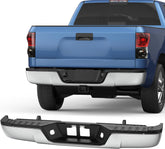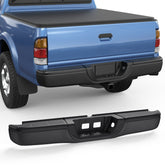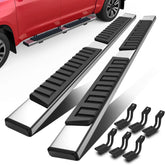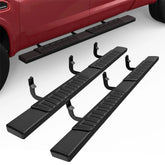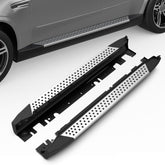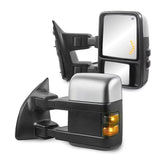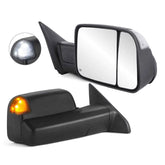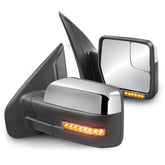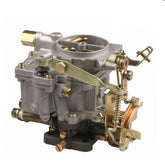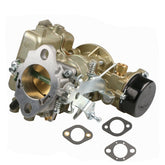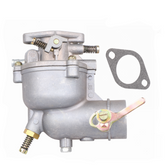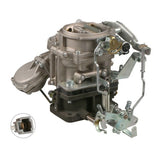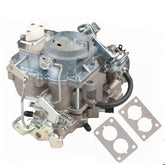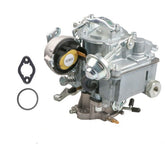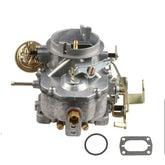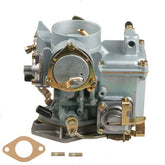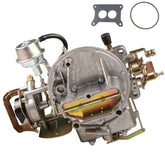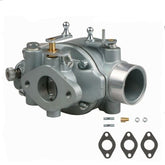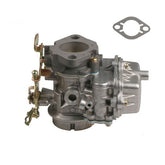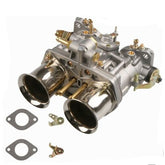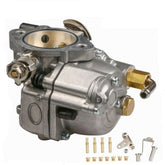Filter
14 results
20
- 10
- 15
- 20
- 25
- 30
- 50
Best selling
- Featured
- Best selling
- Alphabetically, A-Z
- Alphabetically, Z-A
- Price, low to high
- Price, high to low
- Date, old to new
- Date, new to old
Sort
Sort by:
- Featured
- Best selling
- Alphabetically, A-Z
- Alphabetically, Z-A
- Price, low to high
- Price, high to low
- Date, old to new
- Date, new to old
-
Carburetor Carb For 1986-1988 Suzuki Samurai 1.3L Engin US Model Toy-250 ReplaceVendor: MOSTPLUSFeatures Brand: MOSTPLUS Warranty: 1 Year Interchange Part Number: TOY-250 Surface Finish: Zinc Brand New Replacement Carburetor. Only fit for 1986-1988 Suzuki Samurai with a 1.3L Engine. It's a Non-Computer Controlled Toyota Carburetor that has been found to be a great direct bolt-on replacement...
- $76.97
- $76.97
- Unit price
- / per
-
Carburetor Carb w/ Gasket Set For 1975-1982 Ford 240/250/300 6 CIL D5TZ9510AGVendor: MOSTPLUSDetails: Brand: MOSTPLUS Warranty: 1 Year Interchange Parts No:D5TZ9510AG, D5TZ-9510AG, RSC-300A Type:Mechanical Automatic Choke To mix air and gasoline in a correct ratio to ensure proper engine function. Fitment 1975-1982 Ford 240 250 300 engine YF C1YF 6 CIL Package include: 1X Carburetor &...
- $79.99
- $79.99
- Unit price
- / per
-
Carburetor for Briggs&Stratton 390323 394228 7HP 8HP 9 HP Engine CarbVendor: MOSTPLUSFeatures: Brand: MOSTPLUS Warranty: 1 Year Exact same performance as OE 1x Carburetor 1x Gasket Interchange Part Number: BRIGGS & STRATTON 390323 & 394228 Fitment: 7 & 8 & 9 HP HORIZONTAL ENGINES Models 170401, 170402, 170412, 170417, 170431, 170432, 170435, 170437,170452,170457, 171431, 171432,...
- $27.50
- $27.50
- Unit price
- / per
-
Carburetor w/ Free Gaskets for Briggs & Stratton 498298 495426 692784 495951Vendor: MOSTPLUSSpecification: Brand: MOSTPLUS Warranty: 1 Year Package included: 1 X Carburetor includes FREE Gasket Replace Part Number: 498298, 692784, 495951, 495426, 492611, 490533 Fitment: This is used on 5hp engines, some engines include: 130202 series 112202 series 112232 series 134202 series 137202...
- $24.27
- $24.27
- Unit price
- / per
-
Carburetor Carb For 1969-1987 Toyota Land Cruiser 2F 4230CC FJ40 2110061012Vendor: MOSTPLUSFeatures: Brand: MOSTPLUS Warranty: 1 Year High-quality replacement Carburetor 100% tested for reliability and performance. Top performance for long service life Ensures product service, quality, and long-lasting durability Brand New Manufactured with New Premium Quality Components Heavy duty Maximum reliability Interchange Part Number: 21100-61012...
- $94.89
- $94.89
- Unit price
- / per
-
Carburetor Carb For Jeep BBD 6 Cyl. Engine 4.2 L 258 CU Engine 10-10061Vendor: MOSTPLUSSpecification: Brand: MOSTPLUS Warranty: 1 Year Interchange Parts No:8308,8311,8309,8335,8337,8349,8351,180-6449,1806449, 8355, 8363, 10-10061 Package include: 1X Carburetor & 2 X Mounting Gaskets Fitment: For Jeep BBD 6 Cyl. Engine 4.2 L 258 CU Engine Note * The oil channels of carburetors will be blocked without...
- $86.99
- $86.99
- Unit price
- / per
-
Carburetor Carb For Chevy&GMC L6 eingines 4.1L 250 & 4.8L 292 7043014 7043017Vendor: MOSTPLUSFeatures: Brand: MOSTPLUS Warranty: 1 Year Input Voltage: DC 12V Material: Heavy-duty Zinc alloy construction Part Number: 7043014,7043017,7047314,704731717054303,17054228 Instructions: not included Aftermarket Rochester style 1-Barrel engine carburetor replacement Divorced Choke(Remote Choke, Choke Thermostat on Manifold) Add 5~10% horsepower and maintain near-stock Fuel mileage Flange...
- $91.29
- $91.29
- Unit price
- / per
-
Carburetor Carb w/ Gasket For Dodge Chrysler Plymouth 318 V8 5.2L 6CIL ENGINEVendor: MOSTPLUSFeatures Brand: MOSTPLUS Warranty: 1 Year Mix air and gasoline in a correct ratio to ensure proper engine function. Give your machine the new power it deserves. This carburetor is mostly fit for Dodge for Chrysler 318 V8 5.2L 1967 - 1980 6CIL. Fit...
- $89.26
- $89.26
- Unit price
- / per
-
Carburetor For VW Single Port Manifold 30/31 PICT-3 Automatic Choke 113129029AVendor: MOSTPLUSFeatures Brand: MOSTPLUS Warranty: 1 Year Interchange Parts No: 113129029A, 113 129 029A, 30/31PICT,113-129-029A, 027H 117510E Type: automatic choke Package includes: 1x carburetor for VW, Gasket, Screws Fitment VW Single Port Manifold 30/31 PICT-3 New Carb Carburetor, Air-cooled for VW 30/31 PICT-3 engine with...
- $73.35
- $73.35
- Unit price
- / per
-
Carburetor Carb for 1964-1978 Ford Mustang Comet F100 F250 F350 2100A800Vendor: MOSTPLUSSpecification Brand: MOSTPLUS Warranty: 1 Year Interchange Parts No: 2100 A800 Mix air and gasoline in a correct ratio to ensure proper engine function. Give your machine the new power it deserves. Package includes: 1x 2-Barrel carburetor as the picture shows Mounting gasket &...
- $102.49
- $102.49
- Unit price
- / per
-
Carburetor Carb w/ Gasket Kit For Ford Tractor 600 700 w/ 134 Engine B4NN9510AVendor: MOSTPLUSFeatures Brand: MOSTPLUS Warranty: 1 Year Replaces part numbers: EAE9510D, B4NN9510A, TSX580 Fitment For Marvel-Schebler TSX580 For Zenith 0-13880 For Ford B4NN9510A Special note Equipped to OEM standards. Manufactured and tested to maximum performance
- $50.21
- $50.21
- Unit price
- / per
-
Carburetor Kit For Holley one barrel model 1904 Ford 1957-62 6cyl aluminum alloyVendor: MOSTPLUSDetails Brand: MOSTPLUS Warranty: 1 Year 1 barrel carburetor with a mounting washer, Venturi size: 36mm. Exact match to the OEM, same performance to original. Fitment: 1957 1960 1962 144 170 200 223 inline 6-cylinder engines used in any Ford product. This carburetor is all-new...
- $115.64
- $115.64
- Unit price
- / per
-
Carburetor W/Air Horn For 68-79 VW Beetle 40 IDF Weber 2 BARREL Jaguar PorscheVendor: MOSTPLUSFeature: Brand: MOSTPLUS Warranty: 1 Year 52 Idle Jets, .115 Main Jets, 200 Air correctors, F-11 Emulsion Tubes, .200 Needle & seat. 550 Pump Exhaust Valve Jet w/ Delrin balls, .50 Accelerator Pump Jets & 28mm Venturis. Profiled Throttle (Butterfly) shafts Cold start circuit...
- $110.00
- $110.00
- Unit price
- / per
-
Carburetor Carb For Buell RR1000 Cyclone M2 Harley-Davidson Sportster 11-0420Vendor: MOSTPLUSDetails Brand: MOSTPLUS Warranty: 1 Year 100% new carburetor with adjustable idle mixture screw and high-speed jet Carburetor has a 1-7/8" throat at the butterfly and a 1-9/16" venturi. Tested before shipment. No adjustment needed, Direct fit. Interchange Parts No: 11-0420 Package includes: 1X...
- $62.81
- $62.81
- Unit price
- / per
